
Product roadmaps are an essential part of understanding how to align your product to a long-term vision for product-market fit. They are also one of the key deliverables for product managers and are useful to almost all teams and stakeholders.
What the product roadmap should provide:
- Clear overview of key launch dates and milestones
- Clearly communicate which teams are responsible for what
- Clearly communicate important deadlines and time allocation
- A beacon to align different teams to core company goals and objectives
What the roadmap shouldn’t include:
- Goals and objectives unrelated to the product
- Overload of information about specific product features and specifications for development
- Big Surprises
- Too much data without clear association with company goals or objectives
In this Process Street article, we’ll be looking at:
- What is a product roadmap?
- Planning the product roadmap
- Key elements of a product roadmap
- How to build a product roadmap
- Free product roadmap template
- Best practices for creating a product roadmap template
- Mistakes to avoid when building your roadmap
- More tools for product success
First off, here’s a template you can use to get started building your own product roadmap.
Product roadmap process
For those of you who came just for the template, here it is:
If you’re interested in the why behind this template design, and more insight into an effective product roadmap approach, read on!
What is a product roadmap?
A product roadmap is a way of visualizing the start and finish of a product in the context of concrete business objectives, going from initial design and specification to iterations and launch.
Another way of thinking about a product roadmap is a set of tasks and milestones plotted against a time frame. It’s a detailing of the directions for how you get a product finished and launched.
Product managers can use product roadmaps as communication tools, which can be useful for many different stakeholders.
Product development teams find them useful because it helps align everyone with a single vision and keep work on track, and workers accountable. It also helps top management to visualize the direction of a product and understand key milestones (like important feature release or launch dates).
Even marketing should be aware of the product roadmap, at least on a high-level. This helps them prepare relevant content and marketing campaigns for a synergized product marketing approach.
Roadmaps also allow engineers to assess their capacity for feature requests against planned work.
So basically, a product roadmap should:
- Provide a reference point for key stakeholders to keep track of important development milestones;
- Include a clear articulation of key business goals and objectives;
- Align engineering/product teams with the rest of the company, helping everyone to work together more efficiently.
To learn more about how to build a unique product check out this episode of our Tech Out Loud podcast. In this episode, Bram Kanstein explains what all startups should do before they start building out their product.
Tech Out Loud is the only podcast that brings you the most impactful blog posts from the biggest names in tech, straight to your ears.
You can also listen to this podcast on other platforms. Click to see the full list! If you enjoyed this podcast, subscribe for a new episode each week.
What does a product roadmap look like?
So what does a product roadmap actually look like? Basically it’s a timeline with key product milestones plotted. There are a bunch of ways that might look in practice; from a simple excel spreadsheet like this:
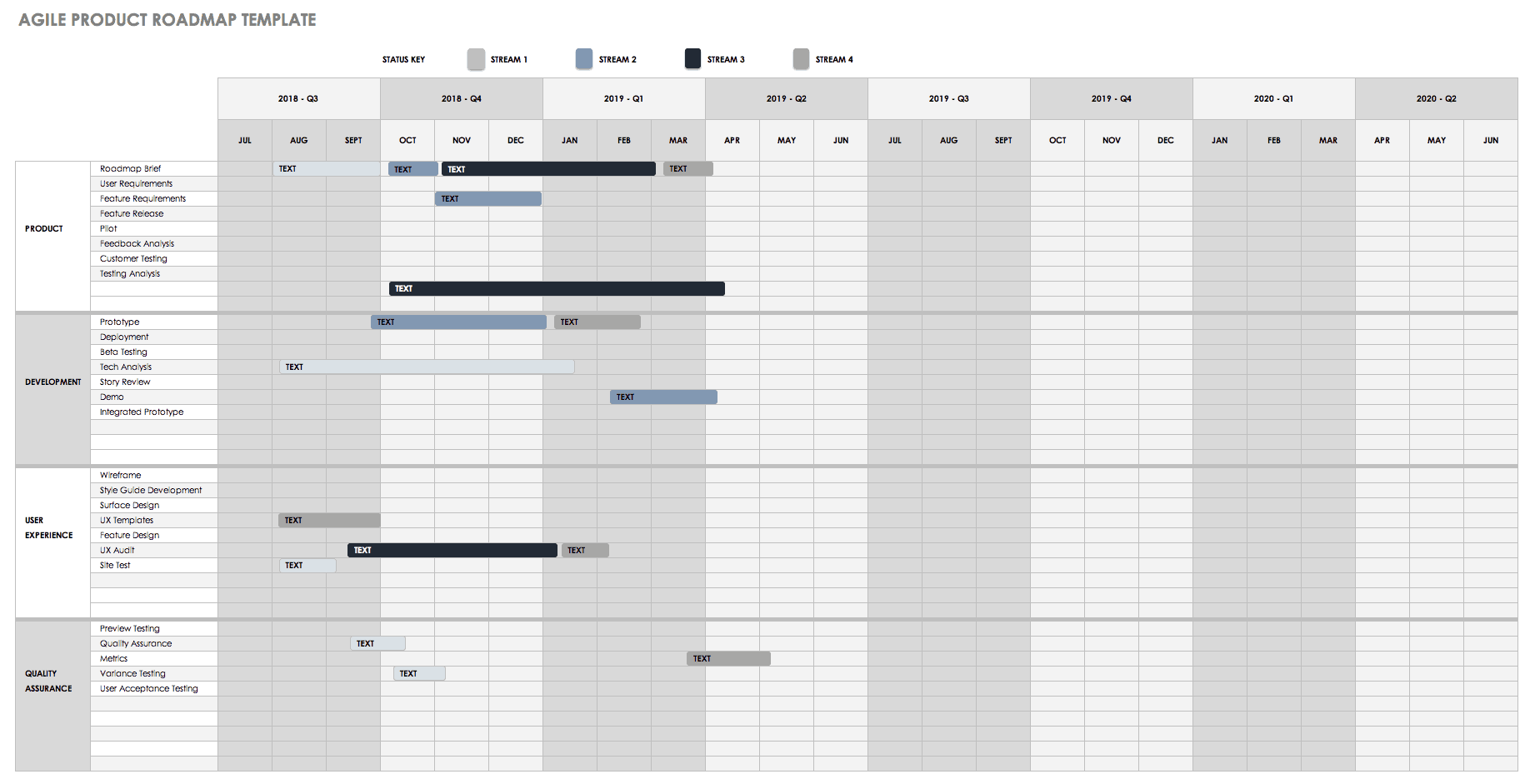
…to a more designed infographic, like this:
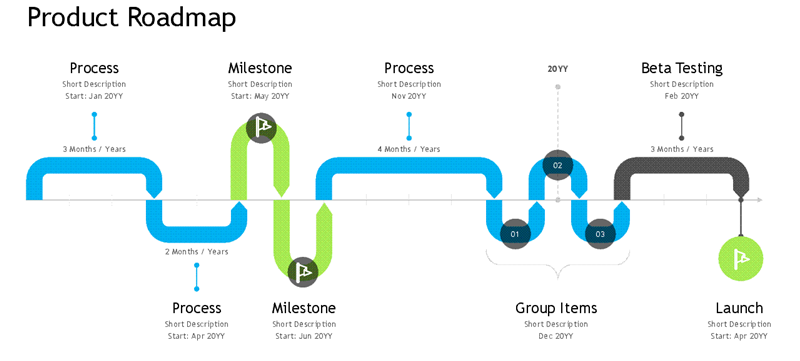
Here’s an example of a Now, Next, Later product roadmap:
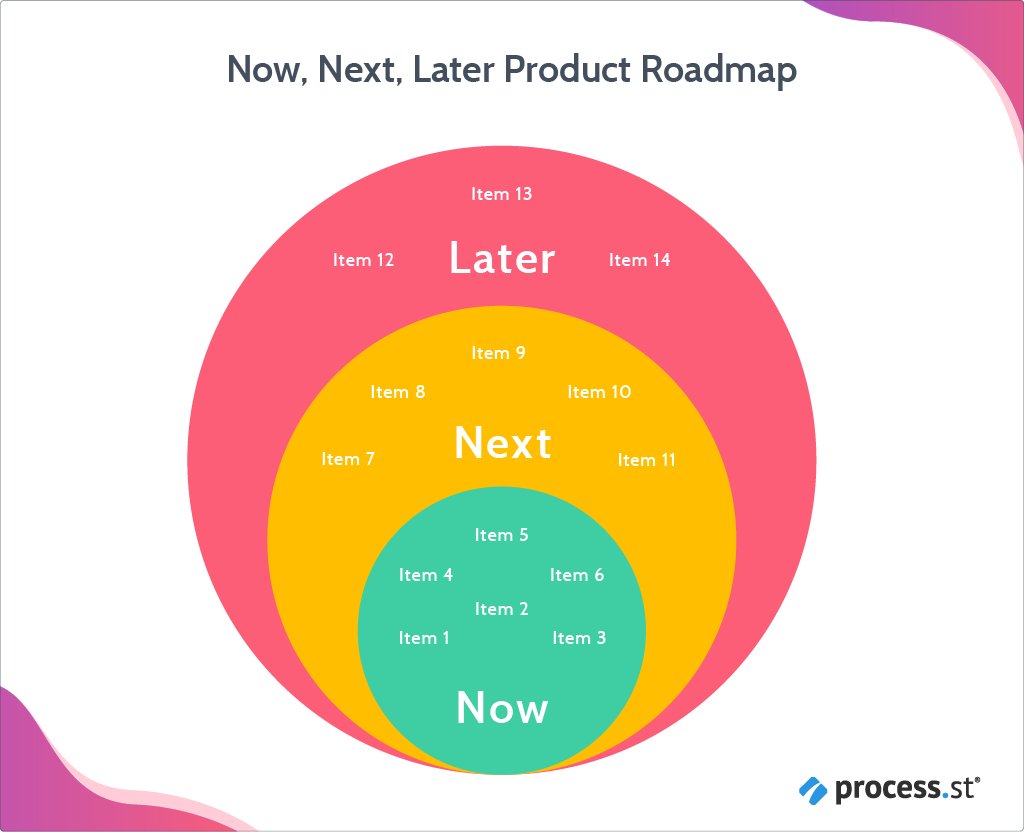
You might even use a flow diagram, like this:
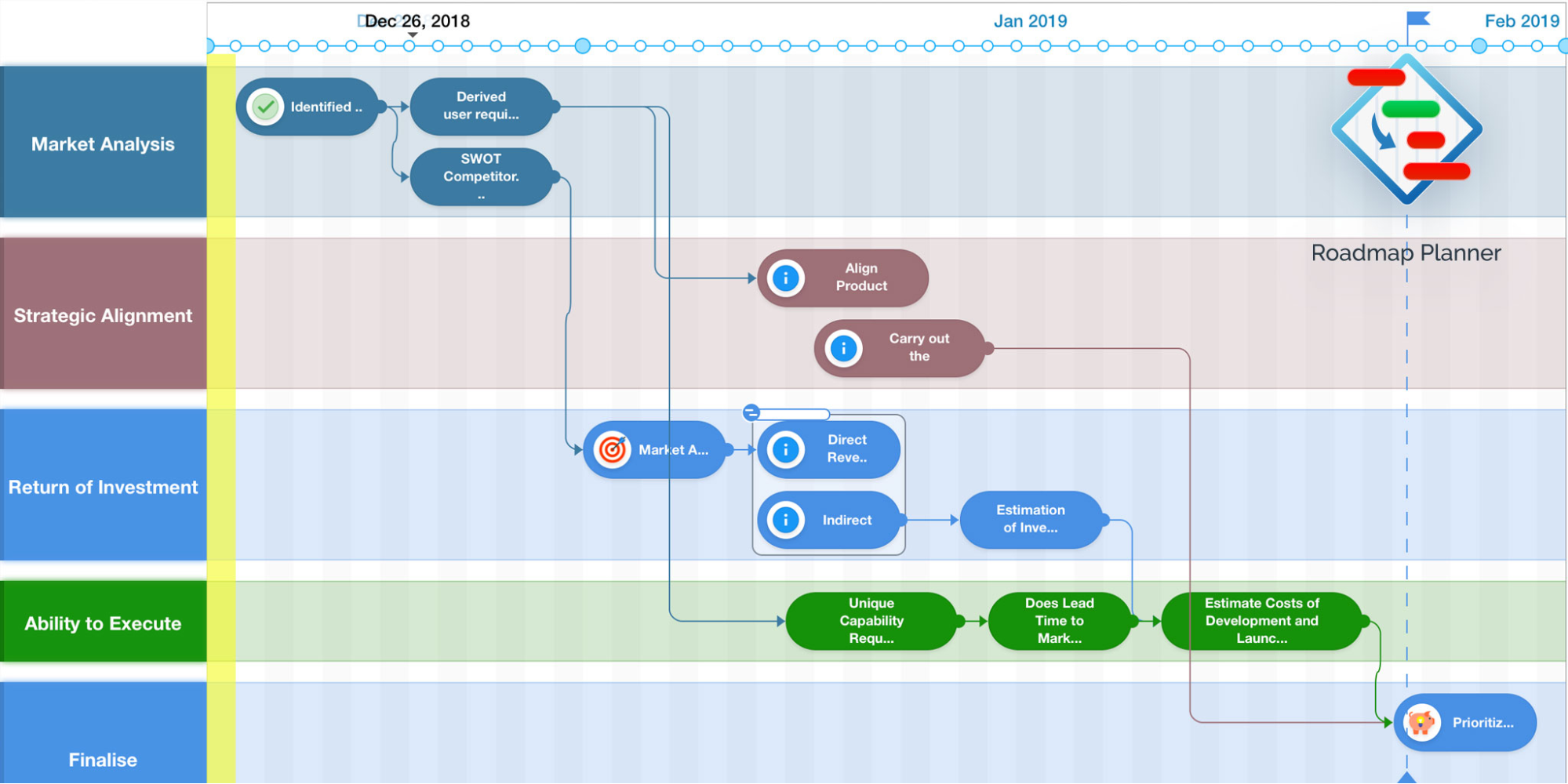
So what should you include on your product roadmap? Useful elements might include:
- Product features (obviously)
- Important processes to be followed at any given part of the roadmap
- Information about key phases of development (prototyping, alpha, beta, release candidate, etc.)
- Other relevant milestones (e.g. important development tasks not related to complete features)
Ultimately, the most important thing is clarity. The roadmap should be easy to understand and clearly communicate relevant information. After all, it’s the whole point of a product roadmap – to provide a central point of reference for product development for the entire organization, as well as relevant stakeholders.
Planning the roadmap: Who is it for?
One of the first things to ask yourself before you start to think about visualizing (or even planning) your product roadmap is this: Who is this roadmap for? What you include in your roadmap will depend on who will ultimately need to see it – a roadmap for engineering teams will look quite different to a roadmap designed for a pitch deck to attract investor attention.
For example, external stakeholders will be more interested in higher-level overviews that omit nitty-gritty details about internal processes or assignment of work. They will want strategic information that covers the scope of multiple quarters, or even multiple years. Think about more general time frames like short-term, mid-term, or long-term.
On the other hand, internal teams like product or engineering will benefit from a deeper breakdown, including tasks and processes associated with each feature. Agile teams will of course benefit from shorter-term planning, in the range of week or month-long sprints, as opposed to years.
In any case, understanding who you are writing the product roadmap for will help you understand its function, and ultimately how to put together a better roadmap.
Key elements of a product roadmap
In this section we’ll take a closer look at the most important elements of a product roadmap, and unpack what function the element serves as well as why it’s important.
A timeline
This is the backbone of the product roadmap. The function is to provide a concrete reference point for feature releases that any interested stakeholders can see and also hold the development team accountable.
The use here comes from being able to align larger organizations to complicated product development schedules and allow different departments (marketing, sales, etc) to act accordingly and plan ahead for these important milestones.
Knowing what lies ahead can help to understand what could potentially cause delays along the way, and this principle applies to pretty much every aspect of product development and management.
This feature-based product roadmap displays simple, high-level feature specifications against a rough timeline:
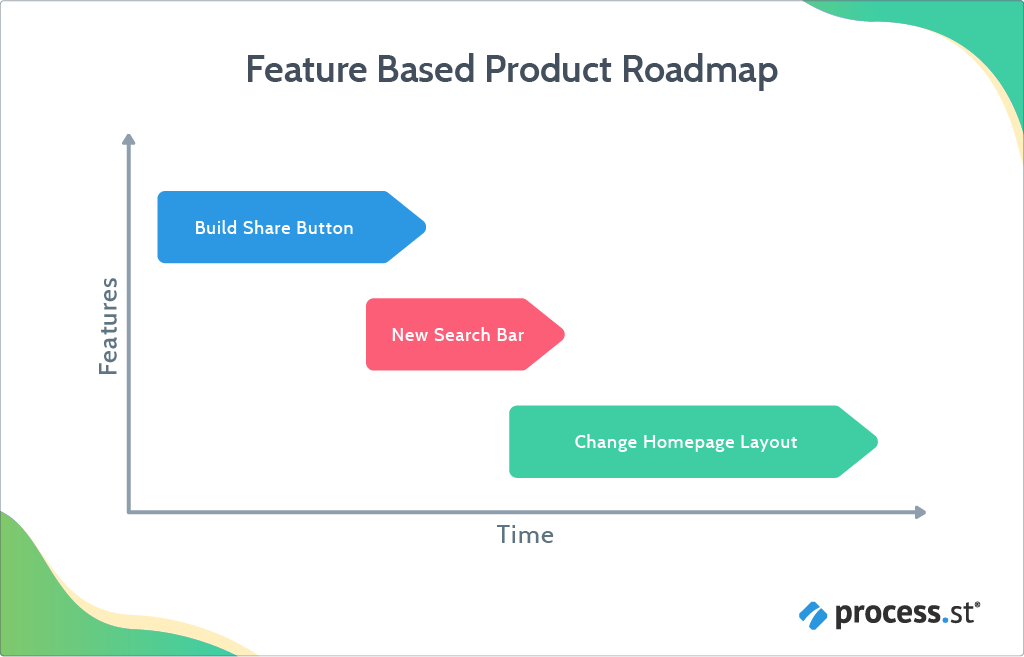
Clearly defined objectives and success criteria
Having a clearly defined criterion of success will help assess the development team’s performance, in addition to the overall successfulness of the roadmap.
Being able to say “ok, things are looking good – we’re on track for this month- but we still need to ramp things up if we’re going to hit the feature milestone for the quarter” can mean the difference between a successful launch and a delayed launch. How can you make such a statement without clearly defined objectives and success criteria to measure against?
Clearly defined tasks and processes
If the timeline is the backbone, well-defined tasks and processes are the vital organs. This is something that will be more useful for internal teams, and extends beyond just the need to be documented for a product roadmap. Good processes that clearly communicate tasks for any given procedure in an organization are essential to the optimal efficiency and performance of any organization.
How does this fit in with a product roadmap? There’s no need to get too complicated – simply listing the most important tasks and processes for any given phase or milestone will be useful to clarify priorities, responsibilities, and allocation of time and resources from day one.
Data-driven decision making
This is an important but often overlooked aspect – when you are building out key milestones and determining time-frames (especially in longer-term roadmaps tailored for executive eyes) you want to make sure you can explain your decision-making process with relevant data.
Whether it’s internal (customer research or feedback to explain demand for a feature) or external (funding round timeframes or similar budget constraints) there’s no good reason to omit this kind of information. It helps stakeholders understand your decision-making process and improves credibility.
A complete product vision
Think of your product roadmap as a timeline of all of the most important events across product development, marketing, and top management teams – it’s not just an engineering specification, rather it should be an opportunity to align all departments against a single, complete product vision.
How to build a product roadmap: Use a template
Building a product roadmap is a complicated process that involves plenty of pre-planning, planning, perhaps some testing, and certainly a lot of discussion and clarification across your teams. There’s no escaping that, but you can make your life easier by using a process to get started.
One of the benefits of using a template is that you’ll have a lot of the work done for you, so you can focus on the specific aspects that are relevant to your business. It’s true that there will always be work to do figuring out certain details like deadlines, milestones, and product features, but there’s a lot of work you can eliminate, and even certain manual tasks you can automate.
Free product roadmap template
Below you can find a free Process Street template for building our own product roadmap. You can edit the template to add or remove tasks or information, depending on your needs.
When you need to build out your own product roadmap, you can simply run this template as a checklist and follow the action items in the process, marking them as complete as you go.
The point of a checklist like this is to steer your efforts and simplify the process for you, so you can focus on building a solid roadmap. However, the template also has interactive form fields for you to enter and record information as you work through the checklist.
This means you can quickly create a summary document of your product roadmap. You can do this a couple of different ways.
One way is to export the completed checklist as a .PDF file. You’ll have a concise summary of your conclusions and a clear process to contextualize how you worked towards those conclusions.
Another way is to automate the process so that a document is automatically generated when you complete the checklist. You can do this with one of Process Street’s integration options, like Zapier, API, or webhooks.
You have more freedom with an integration to specify how the final document will look. Check out this video for a great introduction to help you get started with automations in Process Street:
And here’s the free product roadmap template:
Click here to get the product roadmap checklist!
Best practices for creating an effective product roadmap
The purpose of a product roadmap is to align everyone involved with bringing the product into existence, and help you to build the best product possible.
With that in mind, let’s examine some best practice tips for product teams and product managers with regard to creating an effective product roadmap.
Present a visual product roadmap
An effective product roadmap should be intuitive and easy to understand. Remember, a key goal of the product roadmap is to align development plans and timelines with key company goals and objectives.
Here’s an example of Facebook’s 10-year product roadmap from 2018:

Of course, this kind of roadmap is intended for high-level stakeholders and ultimately, the audience of a conference hosted by Facebook, so the level of detail will be necessarily more simplified. But there’s a valid point to make about how intuitive this roadmap is to read – it’s low on text, and makes use of visual icons and organization to convey a message about product focus and scope.
Common tools to build simple visual roadmaps might include draw.io or even Google Slides, but you can also use more powerful project management tools like Airtable, Trello, or Jira, which provide features like drag-and-drop editors to quickly build out roadmap structures with the potential to have deep levels of nested context (in other words, you could click on a key milestone in Airtable and see all of the associated tasks and information).
Create different versions of the roadmap for different stakeholders
Consider how your internal teams will differ in what they need from a roadmap. Sales will probably have a completely different perspective than, say, engineering. Understanding how different teams need overlap like this is important for avoiding miscommunication.
Different teams will care about different aspects of the roadmap, and including all information for all teams on one single roadmap can quickly become cluttered and overwhelming. Rather, consider how to split roadmaps into team-focused specifications that streamline information based on exactly what each team cares about most.
For top-level executives, the roadmap provides validation that the product aligns with a market; they essentially clarify a product-market fit and help steer the organization’s strategic direction.
For engineering or product development, the roadmap helps keep track of progress and communicates scope and importance of different features, as well as aiding in the agile approach by blocking out a long, complex development process into smaller, more manageable chunks.
For sales, the roadmap helps communicate the value of the product, and to clarify important dates for feature releases or new product launches, as well as a reference point for leveraging comparison with competition and competitive advantages.
For marketing, the roadmap will help align new content and marketing campaigns with feature releases and ensure preparations can be made to generate hype and interest in new features or launches.
For external stakeholders, like customers or investors, the roadmap demonstrates that you value their input and are aware of their specific needs. Sharing a public roadmap with an external stakeholder is a sign that you value their input and generally improves trust and likelihood of stakeholder buy-in.
Include your team in the process for feedback and insight
Following from the previous point, consider how you can bring different members of different teams into the process of building out the roadmap.
Select key process owners and consult them on what they are looking for in the roadmap, and how they intend to use the information in the roadmap. Organize frequent brainstorming sessions or set dates for roadmap review, where you can discuss whether or not changes need to be made, or whether scope needs to be revised.
Take an agile approach
Maintaining a flexible approach to product roadmapping will help you ensure you are always focusing on the most important aspects of your product, and how your product features align with an ever-changing market. Simply setting monthly or quarterly reviews for your product roadmap can help immensely in improving the contingency and long-term effectiveness of a product roadmap, by ensuring that you are constantly reviewing and improving things based on current market trends.
Taking an agile approach should not conflict with the need for a clear, single owner of a product roadmap, however. Making sure that one person alone can make changes to the roadmap will help avoid confusion and mismanagement.
Continue to improve your roadmap over time
Roadmapping your product is about building a long-term plan for product success. Product success is not a static concept – you don’t just “do” product success once – it’s an ongoing process.
Your product roadmap should be gradually and iteratively improved over time.
Rather than being a static document, it should be a way for stakeholders to view a snapshot of the project status at the current time, and that means being flexible in how you incorporate change management and process improvements over time, too.
Product managers, or more aptly product owners, should be providing feedback into the product roadmap to capture important changes in the market, new directions, required resources or shifts in priority. It makes sense to maintain your product roadmap to reflect changes in your product’s development, in order to accurately reflect progress or delays.
Product roadmap mistakes to avoid
On the other hand, there are a few things that might negatively impact how your product roadmap does its job. Take a look at this list and think about whether or not anything sounds familiar, and whether it’s at the cost of the efficacy of your product roadmap.
Failing to understand your most important features
Take a moment to consider your product’s “top” features. The ones you’d be most excited to tell prospective customers about; the ones you feel help your product really stand out and drive home a unique value proposition. Then ask yourself, do your users really care about this feature? Try and build a rational argument in your mind, and justify your excitement with observations from user testing or feedback.
If you come to the conclusion that users seem to care as much as you do about your “top” features, then great job, you probably have a decent understanding of how your features map onto your target market.
But if it seems that, after a good amount of user testing and early-access feedback, it appears that your users don’t really care about this part of your product, then why insist on wasting your time pushing forward with development? It might be time to reconsider your product roadmap and how you see your most important feature milestones.
It’s important to be data-driven when coming to any kind of concrete conclusion about this. Listen to your users, look at your user journeys and figure out where your users are getting frustrated, which features or flows are contributing to churn; similarly, look for the places where users are returning and acting out repetitive patterns – performing UX analysis to better understand user flows in your early product development can help you better understand what features to focus on.
Feature tunnel-vision
Just as you should be clear what your top features are and why, you should also be able to identify when your features become obsolete or whether you should consider making the difficult decision of sunsetting older, less relevant features.
Feature tunnel-vision is common with longer roadmaps, especially when there is not a sufficient process in place for roadmap analysis and change management. You can end up spending a lot of time sinking time and money into figuring out how to make sense of an older, less relevant feature with the rest of a suite of products or services. Sometimes it’s just better to drop it and move on, but making that call is never easy.
Team bias
Product managers sometimes call themselves the “CEO of the product“, and while this can be a useful analogy, it’s also an analogy that should be applied carefully. Daniel Elizalde highlights the kind of problems this kind of thinking can lead to:

In any case, make sure you include other representatives from teams more horizontally aligned with product. You will be able to find some fresh perspectives, and often other teams will probably be working closely with the actual final users of your product. Just remember not to be too influenced by any one singular team, and take a balanced approach to team inclusion!
Imitating your competition
Be cautious about simply imitating what you see other companies doing because it seems to have worked for them. Sure, it might get you so far, but that kind of approach can easily become unstable and leave you with a lack of clear focus and direction. The best thing you can do is stick to your guns, and not be deterred just because your top competitor seems to be taking a completely different approach further on down the road.
More tools to help your product strategy
We’ve covered a lot about product roadmaps so far, but what about other tools for product strategy? Here are some resources you might find useful:
- The Straightforward Guide to Product Strategy (With Templates)
- Product Marketing Strategy: The Key to a Successful SaaS Business
- Product Strategy Template
- Product Launch Checklist
- Marketing Process Toolkit: 10 Checklists to Crush Your Competition
- Software Product Strategy Template
- Sample Product Innovation & Technology Strategy PDF Template
- Product Strategy Template for Agile Product Managers
- Sample Strategic Business Plan
And here are some BPM and workflow management resources to help strengthen other aspects of your team’s productivity as well:
- Workflow Software that Superpowers Your Team
- Business Process Management Software for Streamlined Operations
- What is BPM Software? The Best Business Process Management Software (BPMS)
- 9 Benefits of Business Process Management (BPM) and Why You’ll Love It
- Breakdown of the Best Workflow Management Software
- What is BPM Software? The Best Business Process Management Software (BPMS)
- Every To Do List Template You Need (The 21 Best Templates)
- 6 Types of Project Proposals That Get Approved (and How to Write Them)
- Daily Routine Checklist
- 36 Workflow Apps to Save You From Data Entry Hell
- How to Boost Your Productivity in 3 Effective Ways
- How to Write a Proposal and Get What You Want (Free Templates)
- Ultimate SOP Guide: Standard Operating Procedures Made Easy (Free Templates!)
Do you have any advice for building out a product roadmap? Let us know in the comments, and if your advice is good enough we might just feature you in an upcoming article.







Oliver Peterson
Oliver Peterson is a content writer for Process Street with an interest in systems and processes, attempting to use them as tools for taking apart problems and gaining insight into building robust, lasting solutions.